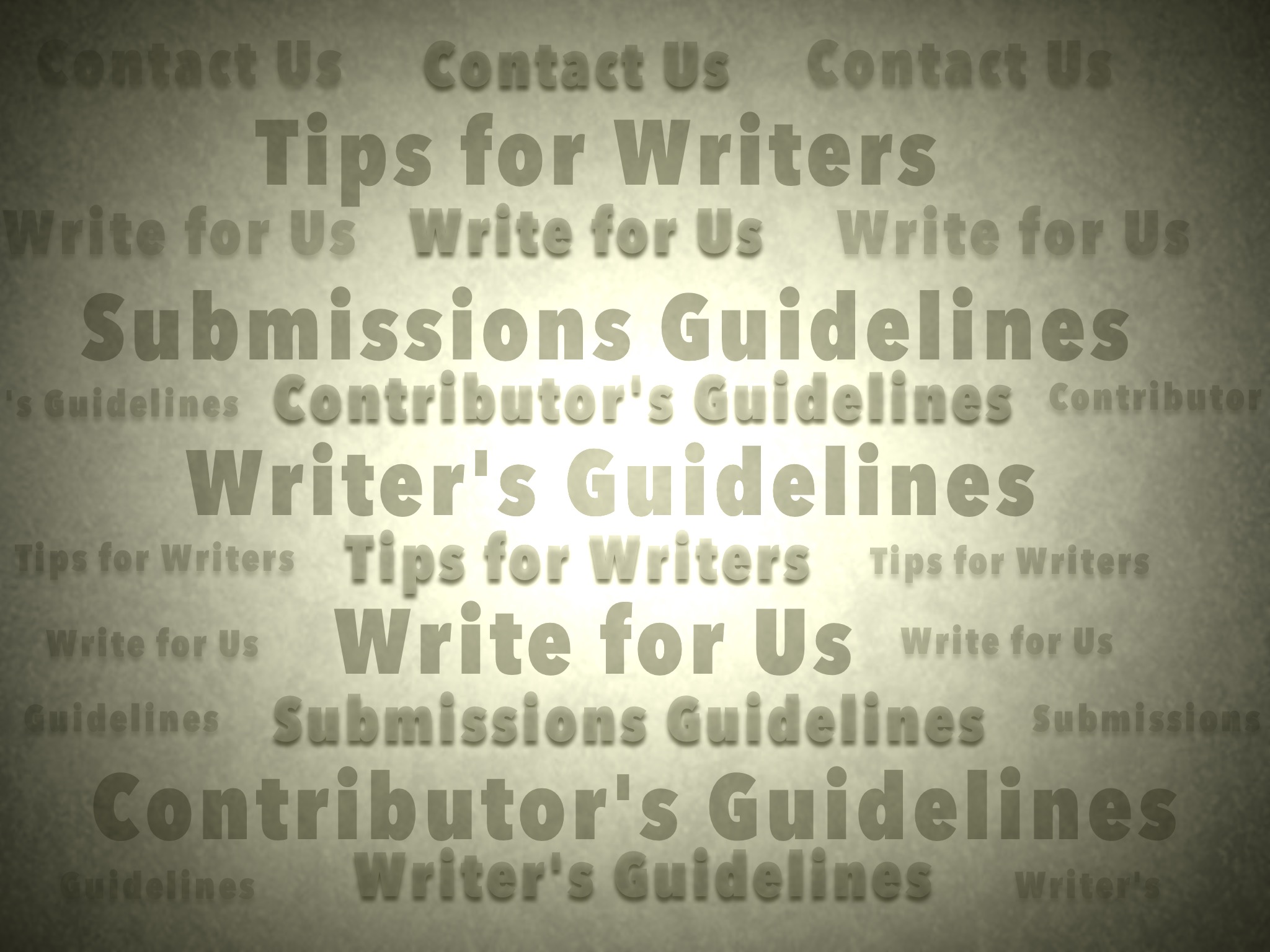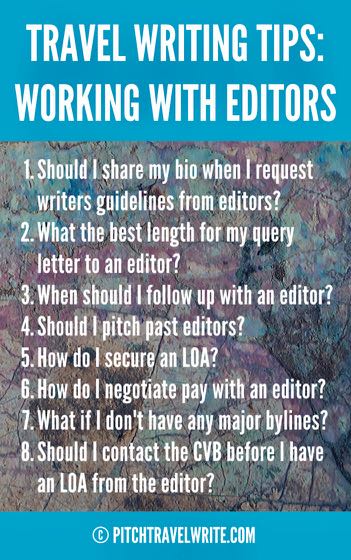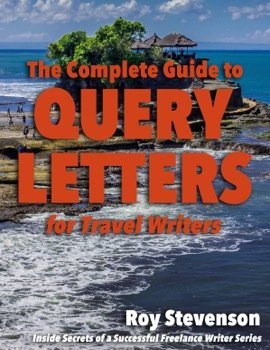- Home
- Tips for Working with Editors
Travel Writing Tips:
Working with Editors
By Roy Stevenson
Every week I receive emails and Facebook requests asking for my best travel writing tips. Many of your questions have to do with working with editors.
In this post I've included a selection of questions - and answers - related to working with editors such as when to follow-up, how to get a letter of assignment (LOA), negotiating pay rates with editors and which comes first - the LOA or the comps?
Read through these tips and see how you are at handling editors professionally - and for being most successful in selling your story ideas:
Travel Writing Tip #1: Requesting Writer's Guidelines from Editors
Hi Roy, I have a question about sending an email regarding writer’s guidelines. When sending an inquiry for the guidelines, should I write a little about myself? Or should I just request the guidelines with minimal info?
I have sent out a few emails to editors requesting their guidelines, but still haven't received any response. Love reading your website and newsletters, great information.
A: If you're looking for writer's guidelines, always check the magazine's website before writing to an editor. In most cases you'll find it tucked away somewhere on their website. It can be listed under "Writer's Guidelines", "Contact Us", "Write For Us", or any number of other titles, so be sure to dig around for a while. They pop up in all sorts of unexpected places.
 Editors and publishers have different names for writer's guidelines. Here are some of the most common names.
Editors and publishers have different names for writer's guidelines. Here are some of the most common names.If there are no Writer's Guidelines online, then email the editor to request a copy. If the editor does not reply, they probably don't have any official writer's guidelines.
Or, if the editor doesn't reply in a timely manner (say a week, or 10 days at most), then assume they don't have written guidelines.
Many magazines don't have writer's guidelines, online or in print. If this is the case, you have to fly blind and send a query that you think is appropriate for the magazine's voice, ‘social’ strata (budget travel vs. family travel vs. luxury travel), article length, etc. You can determine this by reading through a few back copies of the magazine. It won’t take long to figure out what the magazine is about.
When you write to an editor, I don’t recommend putting any personal details in your request letter. Just keep it to a simple one or two sentence request, such as;
"Dear (Editor's Name), I'd love to pitch your magazine some travel story ideas. Please send your writer's guidelines as an attachment, to my email address. Many thanks. Best Regards, (Your Name).
You're not pitching the editor a story, so there's no point in sending information about your travel writing. You’ll do this in your query letter. You can learn more about this travel writing tip and writer’s guidelines in this article on my website.
Travel Writing Tip 2: The best length for query letters to editors
Q: How long should my query letter be? I have plenty of interesting information to put in the query letter, but think it might make it too long.
You should take as much space in your query letter as you need to do justice to your story idea. I don’t put any constraints on the length of my query letters. Instead, I try to paint a picture in my queries and use as many pages as it takes to do that.
You can see a sample query letter in this related article ...
Do you need help writing query letters that catch the attention of editors?
If you're looking for a guide to help you write query letters to editors, I've written The Complete Guide to Query Letters for Travel Writers to help you. It includes everything you need to know about query letters, along with 20 sample query letters that you can use as templates for your own queries.
Travel Writing Tip 3: Following Up With An Editor
Hi Roy - Four weeks ago I pitched my story to a magazine that I thought would be a perfect fit and because the magazine pays well. It’s a popular, high circulation glossy and I really want to see my story in this magazine.
I have not heard back from the editor. How long should I wait to hear back from the editor? Should I send her another email?
A: First of all, I think it's a mistake to hold out in the hopes of placing your story in one targeted magazine, no matter how much you want to be published there. The best approach, and my travel writing tip is to query as many magazines as you can find, relevant to your story angle.
After four weeks, it does not seem that this editor is interested in your story. I would move on and pitch a whole bunch of other magazines.
Holding out for larger, well-known publications are not likely to pan out. High paying magazines are the most competitive.
Typically if an editor is interested in your pitch you will hear back within a few days. You should keep pitching other magazines.
You can try sending an email to the editor. Editors get busy and sometimes things get lost in the shuffle. If you decide to send her a follow-up email, ask her for a decision. Here's an article I wrote about unresponsive editors to give you more thoughts about your situation...
Travel Writing Tip 4: Pitching Editors from Your Past
Q: I have worked with several magazine and newspaper editors in the past, but some of the magazines have folded, some of the editors have changed, and some of the magazines have changed their editorial thrust. It used to be so easy to sell my stories to these editors. What should I do? Should I keep pitching them?
A: I'm afraid the days of being selective in travel writing have vanished.
Certainly there are plenty of full- and part-time travel writers out
there that still maintain a solid working relationship with editors.
But, wise freelancers always increase their outlet base as a hedge
against magazines failing, editors changing, and editorial thrust taking
new directions.
You are correct that you can no longer rest on your laurels and assume that editors you have worked with in the past will continue to snap up your story ideas. Publications change, travel writing has become more fluid, and magazines and newspapers have taken serious hits from the Internet over the past few years.
I’d suggest you blast your queries out to every magazine that seems to be a good fit for your story - don’t limit your queries to editors you know, especially if they’re not responding.
Be aggressive in approaching several magazines for each story idea, and don’t forget about magazines in different countries that might also be interested in your stories.
Here are some other articles related to this topic:
Simultaneous Submissions: Sell More and Do It Faster
Earn More: Sell Your Travel Articles Around the World
Coping Strategies for Travel Writers: When Editors Change...
Travel Writing Tip #5: Securing a Letter of Assignment (LOA) from an Editor
Hi Roy - I met you, at the San Diego conference, along with several hundred others. I’ve been sending query letters and follow up letters, and getting good results. My question is regarding not only “where” but "who" to contact for the letter of assignment?
I will be traveling after the holidays to several locations of South Florida and to some islands, and a letter of assignment could certainly help in obtaining comps.
I read every word you write in your weekly newsletter and certainly respect your comments. Let me know what I might do to get the letter(s) for my travels. I have had nine articles accepted, but I am waiting for confirmation of publishing status.
A. Congratulations on your fast success, and securing those assignments. Very impressive!
It
sounds like you pitched some magazine editors and they have replied,
saying they would like your articles and will publish them.
I've got a few travel writing tips to address your question:
1. Be sure the editor is commissioning your articles, versus some vague
"I'll have a look at them and might publish them" comment. If the email
is too vague, you need to email back and ask if there is intent to
publish.
2. To keep it clean and tidy, you can send an email to the editor requesting an "official" email from him. This email should state that the editor has intent to publish your article when you submit it to them (subject to receiving a well-written, publishable article, of course).
3. Once the editor officially commissions your article, the acceptance email will suffice as your Letter of Assignment. This is what I use for LOA’s, to get complimentary travel all the time.
The Visitor's Bureau Media/PR people want to see that you have an outlet or two interested in publishing your proposed stories. They need some sort of confirmation or proof that you do indeed have outlets, as you claim.
4. Once you receive the “acceptance” email back from the editor, you can simply forward it on to the Visitors Bureau media/PR rep at your destination.
5. When corresponding with the CVB or tourism media rep, you need to outline your assignment requirements. Tell them what you need to see and when you will make the trip so they can help with your itinerary.
This little email dance with editors and Visitors Bureau media reps is too lengthy for me to comprehensively answer in these travel writing tips, but you can learn more in my eBook, How To Land Press Trips and Fam Tours.
There's a certain protocol involved and if you mess it up, you'll miss out on some nice complimentary travel gigs. Beginners do tend to be overzealous and turn the Visitors Bureau people off, which can result in you paying your own way for your trip.
My eBook covers all the detailed information you need when corresponding with CVB’s and media reps, make sure you do it right. How to Land Press Trips and Fam Tours can save you thousands of dollars on future assignments and is a very small investment for the value received.
Travel Writing Tip #6: Negotiating Pay with Editors
Hi Roy - I’ve heard that freelance writers should negotiate with editors about payment for their articles. Should I do this?
A: Some freelance experts suggest that you negotiate your fees with editors. But, generally, I don’t haggle with magazine editors over their payments, unless I’m prepared to withdraw my article from their consideration.
Editors have budgets and guidelines for paying their writers, and I go along with the rates they advertise. As far as travel writing tips go, I haggled with an editor once and got an additional $50 for my efforts. So it’s possible to do this, but generally I don’t think it’s worth the effort. I prefer to accept what the editors offer.
Rather than squeezing more money out of one editor, I like to find other editors that will be interested in the same article or a similar one and resell my article to them.
To make the most money possible from each article, I use techniques like reselling, repackaging and repurposing to earn more from each one. See the links referenced for more information about how I do this to earn more for each story I write.
Travel Writing Tip #7: What do I say to an editor if my bylines are sparse?
Q. As far as a writers bio, I don't have any major print clips.
I have written for an online women's motorcycle mag for the past year
that is undergoing changes and have posted these on
my website. I only have one article in print mags (a motorcycle
article for a local city magazine).
I am in the
transition of moving from public relations writing to travel and so
have an extensive speaking bio and a self-published book that made the
Amazon best-seller list. Any suggestions for making the most of what I
have? Thank you for taking the time to answer this!
A. For your writing credentials and bylines, you can do something like this in your query letters:
I'm
a full time professional freelance travel writer with X articles
published online in XX Magazine and in XX Magazine. My self-published
book, NameOfBook, made the Amazon.com Best Seller list.
My
work is thorough and I'm used to meeting tight deadlines. I'm able to
work to editorial guidelines, and can produce a high volume of good
quality copy that needs little editing. For clips of my work please go
to: (Place Links to Your articles Here). My website is (Link to Your
Website).
Thank
you for consideration of this article. Please contact me if this piece
looks like a good fit for your magazine. I look forward to hearing from
you at your convenience.
I've written an article called "No Bylines - No Problem" that will give you more information.
Travel Writing Tip #8: Do I need an assignment before asking for comps?
Roy, I found an opportunity in a news article and I'm wondering if
I should try to find a magazine to accept the article idea first or
reach out to the state and offer my idea of the trip? I would need help
with travel costs because it's an expensive one and I don't have a lot
of travel articles placed yet. Of course, I want to write as many
angles as possible if I can get this trip. So, should I contact the CVB
or Tourist Board first since I don't have contacts with major
publications yet?
A. Your first task is to get one or
more assignments with magazines or newspapers before you approach the
state or local tourist agencies. Online publications count, too, as the
tourist agencies want to use every avenue for getting word out about
their territory.
The tourist offices won't be able to help you until you have your assignments confirmed by the editor of a magazine(s) so pay attention to this travel writing tip - it's critical!
I
recommend securing more than one assignment when you’re looking for
assistance with travel expenses. The more assignments you have, the
better chance you have of the state tourist agency helping with
airfare. And the local CVB will not line up comp accommodation/meals
for you until you have assignment(s).
So fire out those query
letters to any magazines or online travel magazines that you think would
be interested in your story. Once you have your assignments, then
contact the tourist agencies. Here's a guide I wrote that tells you exactly how to do it:

Special Report:
How to Land Press Trips and Fam Tours
I've written a guide about how to land press trips. It will tell you everything you want to know about how to get into the inner circle and get invited on regional, national and international press trips.
For More Travel Writing Tips:
Sign
up for my free weekly e-Zine with marketing tips about selling your
stories. It's full of travel writing tips about what's happening in the world of travel writing, the craft of travel writing, advice about running your business, and more. We never sell your name and we don't spam. We do offer discounts to our subscribers and will let you know when we're running any special offers or events.

Roy Stevenson is a professional travel writer and the author of www.PitchTravelWrite.com. Over the past ten years, he’s had more than 1000 articles published in 200 magazines, trade and specialty journals, in-flights, on-boards, blogs and websites and has traveled on assignment around the U.S. and to dozens of international destinations.
IF YOU ENJOYED THIS POST, GET UPDATES. IT'S FREE.














